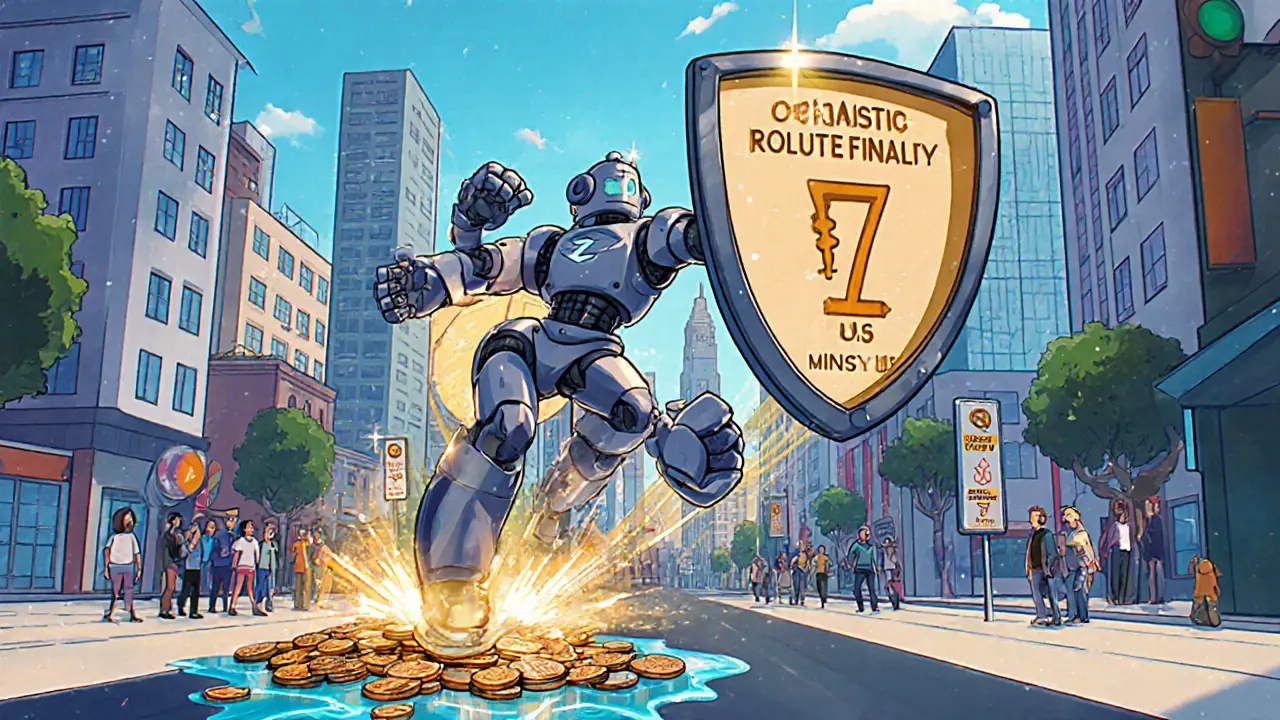ZK-Rollup Gas Fee Calculator
How ZK-Rollups Save You Money
Ethereum mainnet fees can reach $50 per transaction during peak times. ZK-rollups reduce fees to just $0.02-$0.15 per transaction. Enter your transaction volume to see your potential savings.
By late 2023, Ethereum was handling over 12 transactions per second. That’s not enough for millions of users trying to swap tokens, mint NFTs, or lend crypto. Gas fees spiked to $50 during peak times. Something had to change. Enter ZK-rollups - the most promising scaling solution Ethereum has seen yet.
What Exactly Are ZK-Rollups?
ZK-rollups are Layer 2 networks built on top of Ethereum. They don’t replace Ethereum. They make it faster and cheaper by doing the heavy lifting off-chain. Instead of posting every transaction to Ethereum’s main chain, ZK-rollups bundle hundreds or thousands of transactions into one batch. Then, they prove to Ethereum that those transactions are valid - without revealing the details. That proof? It’s a zero-knowledge proof. Think of it like this: You want to prove you know a secret password without saying the password. A ZK-proof lets the network verify that a batch of transactions is correct - without seeing the inputs. This keeps privacy intact and cuts data costs by 80-90%. Three major ZK-rollups are leading the charge: zkSync Era, Starknet, and Polygon zkEVM. Together, they processed over 350 million transactions and moved $1.2 trillion in value by Q3 2023. That’s not small. It’s the real deal.How Do ZK-Rollups Actually Work?
There are three core pieces to every ZK-rollup:- An on-chain smart contract that verifies the cryptographic proof.
- An off-chain virtual machine that runs all the transactions (like a mini-Ethereum).
- A Merkle tree that tracks the state of all accounts and balances.
- Users send transactions to the rollup’s sequencer (a centralized server that orders transactions).
- The sequencer batches them and runs them through the off-chain VM.
- A ZK-proof is generated - a mathematical guarantee that all transactions were executed correctly.
- The proof and a compressed summary of the state change are sent to Ethereum.
- Ethereum’s verifier contract checks the proof. If it’s valid, the state update is accepted.
SNARKs vs STARKs: The Two Types of ZK-Proofs
Not all ZK-rollups are built the same. There are two main types of zero-knowledge proofs: SNARKs and STARKs.- ZK-SNARKs (used by zkSync and Polygon zkEVM) are smaller and faster to verify. But they need a one-time trusted setup - a ritual where keys are generated and destroyed. If someone kept those keys, they could fake proofs. It’s a small risk, but it exists.
- ZK-STARKs (used by Starknet) don’t need a trusted setup. They’re fully transparent and quantum-resistant. But the proofs are bigger - around 100-200 KB - which makes them slower to verify on-chain.
Why ZK-Rollups Beat Optimistic Rollups
Optimistic rollups like Arbitrum and Optimism are the other big Layer 2 solution. They’re simpler to build and have better EVM compatibility - meaning most Ethereum apps work out of the box. But they have a fatal flaw: fraud proofs. Optimistic rollups assume transactions are valid unless someone challenges them within a 7-day window. That means if you want to withdraw your funds, you wait a week. ZK-rollups don’t have that problem. Their proofs are valid the moment they’re submitted. Finality takes 15-30 minutes - not days. That’s why Uniswap on zkSync processed $4.2 billion in September 2023, while its Arbitrum version did just $1.8 billion. Speed matters in DeFi. ZK-rollups also use far less data. Optimistic rollups post full transaction data to Ethereum. ZK-rollups post only state diffs. That cuts Ethereum’s data load dramatically - a huge win as Ethereum prepares for proto-danksharding in 2024.
Real-World Performance: Fees, Speed, and Throughput
Here’s what users actually experience:- Fees: $0.02-$0.15 per transaction on ZK-rollups vs. $1.50-$50 on Ethereum mainnet.
- Speed: zkSync Era handles up to 2,000 transactions per second. Starknet does around 100. Ethereum? 12-15.
- Finality: 15-30 minutes for ZK-rollups. 7 days for Optimistic rollups.
- Data compression: 100x reduction compared to posting raw transactions on Ethereum.
The Catch: What ZK-Rollups Still Struggle With
ZK-rollups aren’t perfect. They have real problems. First, proof generation is computationally expensive. Generating a ZK-proof requires powerful hardware - often 64+ GB of RAM and multiple high-end CPU cores. Most developers don’t have that. That’s why building ZK-native apps takes 3-6 months, compared to 2-4 weeks for Optimistic rollups. Second, centralized sequencers. Every major ZK-rollup - zkSync, Starknet, Polygon zkEVM - relies on a single company to order transactions. That’s a single point of failure. If the sequencer goes down, users can’t transact. Ethereum’s core value is decentralization. This is a trade-off. Third, developer tools are still immature. Writing ZK circuits in Cairo (Starknet) or Zinc (zkSync) is like learning a new programming language. Most Solidity devs aren’t cryptographers. Consensys found that 68% of developers hit proof generation failures during early development. Fourth, liquidity is fragmented. You can’t just move your assets between zkSync, Starknet, and Ethereum like they’re one network. You need bridges. And bridges break. In October 2023, the Polygon zkEVM bridge went down for 12 hours, locking up 8,500 transactions.Who’s Using ZK-Rollups Today?
Adoption is growing fast - and it’s not just retail users.- dYdX moved its entire perpetual trading platform to StarkEx. It now processes $1.2 billion in daily volume.
- MetaMask integrated zkSync in Q3 2023. It now has 1.2 million unique users on the network.
- JPMorgan’s Onyx is building a permissioned ZK-rollup for interbank settlements.
- Accenture deployed Starknet for a European bank’s cross-border payment system.

What’s Coming in 2024 and Beyond?
The roadmap is aggressive:- Proto-danksharding (EIP-4844) - launching in Q2 2024 - will reduce ZK-rollup data costs by 90%. This could cut fees even further.
- zkSync 3.0 (Q3 2024) will introduce native account abstraction and better proof aggregation.
- Starknet 1.0 (Oct 2023) already cut proof generation time by 40%.
- Hyperchains (zkSync) let teams build their own Layer 3 networks with shared security - like subnets for specific apps.

Shanell Nelly
November 16, 2025 AT 19:17ZK-rollups are honestly a game-changer. I switched from Ethereum mainnet to zkSync last month and my gas fees dropped from $20 to like 5 cents. I can finally afford to mint my NFT collection without selling a kidney. 😍
Aayansh Singh
November 17, 2025 AT 18:17Let’s be real - this whole ZK hype is just crypto bros pretending they understand zero-knowledge cryptography. You think a 100x data compression is magic? It’s just obfuscation wrapped in math jargon. And don’t get me started on those centralized sequencers - you’re trading one centralized entity for another. This isn’t decentralization. It’s rebranding.
Rebecca Amy
November 19, 2025 AT 12:30idk man i read like half of this and got bored. fees are low sure but like… do i really care if my swap takes 15 min instead of 5? 🤷♀️
Darren Jones
November 19, 2025 AT 20:29Just wanted to add - if you're a dev trying ZK for the first time, don't panic when your proof generation fails 17 times. It's normal. The tooling is still in alpha. Use the zkSync docs, join their Discord, and don't try to build a complex circuit on day one. Start with a simple token transfer. Baby steps. You'll get there. I did. 🙌
Kathleen Bauer
November 20, 2025 AT 06:29so i tried starknet last week and like… it just worked? no drama. no drama at all. my friend was like 'you switched to what now?' and i was like 'starknet baby' and he just stared at me like i spoke elvish. 🤓✨
Carol Rice
November 22, 2025 AT 01:50STOP acting like ZK-rollups are some miracle cure! They’re not! The sequencer centralization is a joke - and if you think Starknet’s STARKs are 'quantum-resistant' and therefore 'future-proof,' you’re ignoring the fact that 99% of users don’t care about quantum computing - they care about not paying $50 to send $10 of ETH! Also, who gave Polygon a billion dollars? That’s not innovation - that’s venture capital theater!
Laura Lauwereins
November 22, 2025 AT 10:10Wow. So ZK-rollups are the future. And the sequencers? Just… trust us. 😌
Gaurang Kulkarni
November 22, 2025 AT 10:31Everyone talks about fees but no one talks about the fact that generating proofs requires server farms with 64GB RAM and 16-core CPUs. Most devs can't afford that. So they outsource to centralized providers. So now you have a decentralized blockchain powered by a single AWS account. That's the irony. You're not scaling Ethereum. You're outsourcing it to cloud giants. And you call that progress?
Nidhi Gaur
November 22, 2025 AT 23:30fr tho why are we even talking about this like its new? i been on zkSync since 2022 and my gas is still 2 cents. its not magic its just math and ppl are acting like its the second coming. chill.
Usnish Guha
November 24, 2025 AT 11:30You people are naive. You think lower fees mean freedom? No. You're just trading one form of control for another. The sequencers own your transaction order. The proof generators own your dev pipeline. The VC-funded teams own your roadmap. This isn't decentralization. This is corporate crypto with better marketing. And you're celebrating it like it's a gift from the gods. Wake up.
Jess Zafarris
November 24, 2025 AT 12:43Interesting. So if Starknet uses STARKs and doesn't need a trusted setup, why does every major ZK-rollup still rely on a centralized sequencer? Is it really just about speed? Or is it because decentralizing sequencers would break the UX? And if so… are we sacrificing core principles for convenience? Just asking.